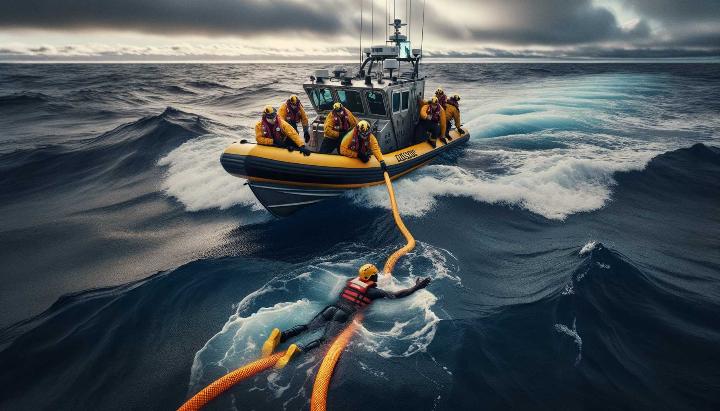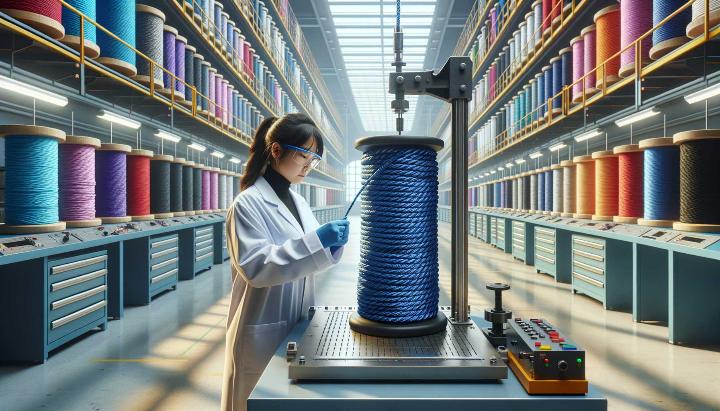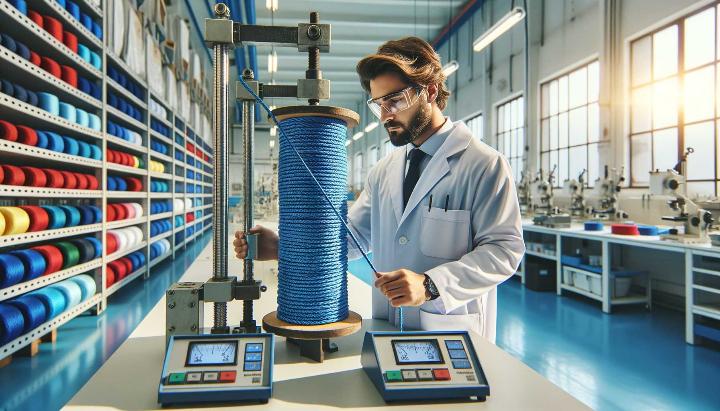Did you know that the right rope could mean the difference between success and failure in your next project? Whether you're scaling mountains, securing cargo, or crafting industrial solutions, understanding the intricacies of spectra rope, bungee cord, and shock cord specifications is crucial. But navigating this complex world can be daunting.
That's where iRopes comes in. With 15 years of experience crafting high-quality ropes in China, we've mastered the art of synthetic cordage. Our expertise spans 2348 unique cordage options, catering to marine adventures, racing sports, industrial applications, and safety protocols.
In this expert guide, we'll unravel the mysteries of rope specifications, exploring the strength of spectra rope, the versatility of bungee cords, and the shock-absorbing prowess of shock cords. You'll discover why our commitment to using advanced synthetic fibres like UHMWPE, Technora™, and Kevlar™ sets us apart in the industry.
Get ready to elevate your rope game and experience the true quality of "Made in China." Let's dive in and explore how the right rope can transform your projects and push the boundaries of what's possible.
Understanding Spectra Rope Specifications
Have you ever wondered what makes Spectra rope so special? Let me take you on a journey through the world of high-performance synthetic fibres. Spectra rope, a marvel of modern engineering, is crafted from ultra-high-molecular-weight polyethylene (UHMWPE). This incredible material boasts strength that rivals steel while remaining remarkably lightweight.
Key Features of Spectra Fiber Rope
As someone who's spent countless hours working with various ropes, I can confidently say that Spectra stands out from the crowd. Here's why:
- Unparalleled strength-to-weight ratio: Imagine a rope that's 15 times stronger than steel at the same weight. That's Spectra for you!
- Impressive durability: These ropes laugh in the face of abrasion, chemicals, and UV rays. I've seen Spectra ropes outlast traditional materials in harsh marine environments.
- Low stretch properties: When you need minimal elongation under load, Spectra delivers. This makes it ideal for applications where precise control is crucial.
- Floating capability: Unlike many synthetic ropes, Spectra floats on water. This can be a real lifesaver in marine rescue operations.

Comparing Spectra and Dyneema Ropes
You might be wondering, "How does Spectra stack up against Dyneema?" It's a great question, and one I often get from clients. The truth is, they're remarkably similar. Both are UHMWPE fibres with exceptional strength and low weight. However, there are subtle differences:
| Feature | Spectra | Dyneema |
|---|---|---|
| Strength-to-weight ratio | Excellent | Excellent |
| UV resistance | Good | Very Good |
| Creep resistance | Good | Very Good |
In my experience, both perform exceptionally well in most applications. The choice often comes down to specific project requirements and personal preference.
When selecting a Spectra rope, consider factors like the required tensile strength, diameter constraints, and the specific environmental challenges it will face. Remember, the right rope can make all the difference in your project's success.
Have you used Spectra rope in your projects? I'd love to hear about your experiences and any questions you might have about incorporating this incredible material into your work.
Understanding Bungee Cord Specifications
As an expert who's spent years working with various types of ropes and cords, I've come to appreciate the unique properties of bungee cords. These elastic marvels are more than just stretchy strings - they're precisely engineered tools with a wide range of applications. Let's dive into the world of bungee cord specifications and unravel their secrets together.
Types and Diameters of Bungee Cords
Bungee cords come in a variety of shapes and sizes, each designed for specific uses. In my experience, the most common types are:
- Straight cords: These versatile workhorses are what most people picture when they think of bungee cords.
- Endless rings: Ideal for bundling and securing oddly shaped items.
- Single or double braided cover cords: These offer extra durability and a sleek appearance.
When it comes to diameter, bungee cords typically range from 0.25 to 0.87 inches. Commercial bungee ropes usually fall between 0.25 to 0.62 inches. The diameter you choose can significantly impact the cord's strength and performance.

Choosing the Right Bungee Cord for Your Needs
Selecting the perfect bungee cord isn't just about picking the stretchiest option. You need to consider several factors:
- Elastic strength: Most bungee cords stretch 100% to 125% of their original length. Consider the load you'll be securing.
- Length: Measure your application carefully. A cord that's too short won't reach, while one that's too long could be dangerous.
- End fittings: Hooks, loops, or bare ends? Each has its place depending on your needs.
Here's a quick guide to help you match bungee cord specifications with common applications:
| Application | Recommended Diameter | Typical Length |
|---|---|---|
| Lightweight camping gear | 0.25 - 0.37 inches | 12 - 24 inches |
| Securing cargo on vehicles | 0.5 - 0.62 inches | 36 - 48 inches |
| Heavy-duty industrial use | 0.75 - 0.87 inches | Custom lengths |
Remember, these are general guidelines. Your specific needs might require a custom solution. That's where iRopes' expertise comes in handy. With our 15 years of experience and wide range of synthetic fibers, we can create bungee cords tailored to your exact specifications.
Have you ever used a bungee cord for an unconventional purpose? I'd love to hear about your creative applications in the comments below!
Understanding Shock Cord Specifications
Have you ever wondered about the stretchy, versatile cords that seem to pop up in everything from camping gear to industrial applications? That's shock cord, mate, and today we're going to unravel its mysteries together. As someone who's spent years working with these elastic wonders, I can tell you that understanding shock cord specifications is crucial for choosing the right cord for your needs.
Decoding Shock Cord Measurements
Let's start with the basics. Shock cords are measured in a way that might seem a bit odd at first: in 1/16ths of an inch diameter. I remember being puzzled by this when I first started working with them. But trust me, once you get the hang of it, it's a breeze.
- Diameter matters: The thickness of your shock cord directly affects its strength and stretch capacity. A 1/8" cord (that's 2/16" in shock cord speak) might be perfect for lightweight camping gear, while a 3/8" (6/16") cord could be better suited for securing heavy loads.
- Length considerations: Shock cords typically stretch 100-125% under full load. This means a 1-meter cord could potentially extend to 2.25 meters when fully stretched.
- Weight capacity: As a rule of thumb, the thicker the cord, the more weight it can handle. But remember, it's always better to err on the side of caution and choose a cord rated for more weight than you think you'll need.

Color Coding and Quality Standards
Now, here's a fun fact that not many people know: shock cords often have a hidden message in their construction. Many manufacturers use a color coding system to indicate when the cord was made. It's like a secret handshake for those in the know!
- Color threads: Look closely at the core of your shock cord. See those colored threads? They're not just for show. They indicate the manufacturing year and quarter.
- Mil-spec standards: If you're working in aerospace or other high-stakes industries, you'll want to pay attention to mil-spec standards. These are the gold standard for shock cord quality and performance.
Speaking of quality, let me share a quick story. I once worked on a project where we initially chose a non-mil-spec cord to save costs. Big mistake. The cord failed under stress, causing a significant delay. Since then, I always emphasize the importance of choosing the right specifications for the job.
Now, you might be wondering, "How does shock cord compare to bungee cord or paracord?" Great question! While they might look similar at first glance, they're quite different beasts:
| Feature | Shock Cord | Bungee Cord | Paracord |
|---|---|---|---|
| Elasticity | High | High | Low |
| Strength | Moderate to High | Moderate | High |
| Typical Uses | Industrial, Marine, Outdoor Gear | Luggage, Light Duty | Survival, Crafting |
Understanding these differences can help you choose the right cord for your specific needs. Remember, in the world of cords and ropes, one size definitely doesn't fit all!
Have you ever used shock cord in an interesting or unconventional way? I'd love to hear about your experiences in the comments below. And if you have any questions about shock cord specifications, fire away! I'm always happy to help fellow enthusiasts navigate the stretchy world of shock cords.
iRopes' Expertise in Synthetic Rope Manufacturing
When it comes to synthetic rope manufacturing, iRopes stands out as a beacon of excellence in the industry. With 15 years of experience under our belt, we've honed our craft to perfection, pushing the boundaries of what's possible in rope technology. Let me take you on a journey through our world of high-performance cordage.
15 Years of Experience in Synthetic Cordage Production
I remember when we first started out, the landscape of rope manufacturing was vastly different. Over the years, we've witnessed - and often spearheaded - remarkable advancements in synthetic fiber technology. Our journey has been one of constant innovation, driven by a passion for creating the best ropes in the business. Our commitment to quality is evident in our range of products, including the 8 Strand Polypropylene Mooring Rope, which revolutionizes maritime safety with superior strength and customization.
- Evolving manufacturing processes: We've continually refined our techniques, incorporating cutting-edge technology to enhance precision and efficiency.
- Expanding material expertise: Our repertoire has grown from basic synthetic fibers to include advanced materials like UHMWPE, Technora™, and Kevlar™.
- Unwavering commitment to quality: Each rope we produce undergoes rigorous testing to ensure it meets our exacting standards.

Revolutionizing the Industry with High-Performance Fibers
At iRopes, we're not just keeping up with the industry - we're leading the charge. Our high-performance fiber ropes are a testament to our innovative spirit and technical prowess. But what makes these ropes so special? Discover more about how our UHMWPE Hoist Rope is revolutionizing industrial lifting with superior strength and safety.
- Unparalleled strength-to-weight ratio: Our synthetic ropes often outperform traditional materials like steel in terms of strength while remaining incredibly lightweight.
- Superior durability: Resistance to UV radiation, chemicals, and abrasion means our ropes last longer in challenging environments.
- Customizable properties: We can tailor our ropes' characteristics to meet specific industry needs, from low stretch for precision applications to high elasticity for energy absorption.
I once worked on a project for a deep-sea research vessel that required a rope with exceptional strength, low weight, and resistance to extreme pressures. It was a challenging brief, but our team rose to the occasion, developing a custom UHMWPE rope that exceeded all expectations. That's the kind of innovation that drives us at iRopes. If you want to explore our range further, check out how our high-quality Kevlar ropes are setting new standards in strength and versatility.
Have you ever wondered how synthetic ropes compare to traditional materials in your industry? I'd love to hear about your experiences and challenges. Drop a comment below, and let's start a conversation about how high-performance ropes could revolutionize your operations.
iRopes by the Numbers
2348 cordage options, 15 years of experience, countless satisfied customers worldwide
As we continue to push the boundaries of synthetic rope manufacturing, we remain committed to our core values of quality, innovation, and customer satisfaction. Whether you're in marine operations, racing sports, or industrial applications, iRopes has the expertise and product range to meet your most demanding rope requirements.
Ready to experience the iRopes difference? Let's talk about how our high-performance synthetic ropes can elevate your projects to new heights. After all, in the world of ropes, the sky's the limit - and we're here to help you reach it.
```htmlDive into the world of high-performance ropes with iRopes, your trusted partner for top-quality spectra rope, shock cord, and bungee cord specifications. With over 15 years of experience, iRopes excels in manufacturing and customizing synthetic fibre ropes such as UHMWPE, Technora™, and Kevlar™. Whether it's for marine, racing sports, industrial applications, or safety, our 2348 cordage options are designed to meet demanding specifications. Discover the unparalleled strength and versatility of our ropes, crafted with precision and the exceptional "Made in China" quality. Explore the importance of detailed specifications for selecting the right rope for your needs, and let iRopes provide the high-quality, custom solutions you require.
Learn More About Our Custom Rope Solutions
To discuss your specific rope needs or inquire about our custom solutions, please fill in the form above. Let iRopes deliver high-quality, tailored products that match your precise requirements and applications.
```